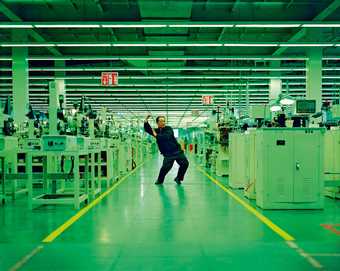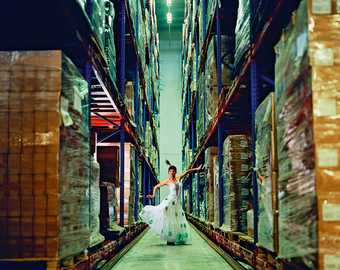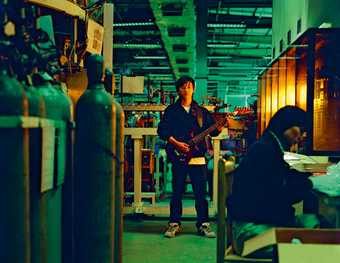In 2005 the Siemens Art Programme invited me to create an art project in the Osram light bulb factory in Guangzhou. It has in the past commissioned artists such as Yang Fudong and Song Dong to produce works related to factories in their native cities. This was a great opportunity for me since my previous work engages with the issue of Chinese urbanisation, and I am very interested in the complex process of industrialisation in the south of the country.
I didn’t want to make a conceptual piece as some other artists had done with installations, nor did I want to create anything too ‘arty’. Previously, for instance, Yang Fudong filmed employees wearing uniforms tied together, while Yang Zhenzhong made a video in which the workers in a Shanghai factory sang in sequence one line from a famous speech delivered by the former president, Deng Xiaoping. I am interested in documentarylike video, and wanted to produce a docu-drama showing the real lives of the employees. It was a rare chance to film inside a factory – usually an inaccessible space. Initially, I was given precise guidelines on which machines or places I could not film, but with the passing of time and them getting to know me, they began not to notice me.
I went to the factory once a week for six months between 2005 and 2006. To start my research, I distributed a questionnaire to around 500 workers. They had to answer in writing or by drawing. For example, I asked them which song they liked singing or what they heard when they closed es, or to draw their working environment. The songs they most liked were about love and fairy tales, or ones that motivated them.

Cao Fei
still from Whose Utopia 2006
video, projection, colour and sound, 19min 58sec
© Cao Fei, courtesy Vitamin Creative Space, Guangzhou

Cao Fei
still from Whose Utopia 2006
video, projection, colour and sound, 19min 58sec
© Cao Fei, courtesy Vitamin Creative Space, Guangzhou
With the information I gathered I hoped to become their audience and produce a work that expressed their emotions and experience – one in which they could see themselves. After I analysed their answers, I selected those I thought were the most interesting and gave their names to the human resources department, who organised a meeting with them.
Every one or two weeks I invited them to participate in workshops which included painting, performance, installations, etc. The factory had to rearrange their tasks on the production line, so the time available for our activities was always very tight, but they became accustomed to looking at art. I helped them to understand how things that don’t necessarily look like it can be art by showing them installations by various artists made with everyday objects. This brought us to the next stage of the process, as I wanted them to use materials from their daily lives to create an artwork.
There were about 30 people, who I divided into five themed groups called dream, ideal, hometown, reality and future. I thought hometown was very relevant, since they were all migrant workers who had come from the countryside. The members of each had to work together and chose to use very different materials and methods. The dream group created a bed covered by a mosquito net, on top of which an employee who was good at painting did a traditional landscape picture; then they put a ladder going upwards to symbolise that dreams come from above. The reality group decided to do a five-minute performance in which they staged an act of daily life, including dialogues based around a computer and using a phone. The future group brought in boxes and bulbs and made a time machine. They also formed a music band, the seven members of which had printed on their T-shirts the characters forming the sentence and song title: ‘my future is not a dream’.
Most of the material in the final video was shot at this last stage of the project, when I felt a connection with the participants, and they with me. This is possibly why many believe that Whose Utopia is a very touching piece, as the feelings that I was able to convey as a director were the result of a long process.

